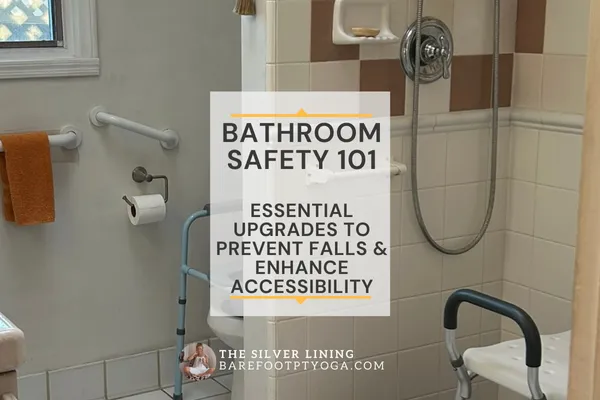
Bathroom Safety 101
Essential Upgrades to Prevent Falls and Enhance Accessibllity
The bathroom is one of the most common places for falls, especially for older adults and those with mobility challenges. Slippery floors, low toilets, and high step-ins can create serious hazards. But with a few simple upgrades, you can make your bathroom a safer and more accessible space.
Below, I'm sharing essential bathroom safety features that can help prevent falls and improve independence. Plus, I've included links to my favorite, highly-rated products that can make these changes quick and easy!
Install Grab Bars for Stability:
One of the easiest ways to enhance safety is by installing grab bars near the toilet and inside the shower. These provide extra stability when standing, sitting, or transitioning between positions is challenging. Unlike towel racks (which aren't designed to support body weight) grab bars are sturdy and designed to assist in the prevention of falls.
Use a Raised Toilet Seat:
A raised toilet seat can make a huge difference for individuals with joint pain or limited mobility. By reducing the distance needed to sit and stand, it eases strain on the knees and hips, making bathroom trips safer and more comfortable.
Add a Shower Chair for Comfort and Safety:
Standing in the shower for extended periods of time can be risky, especially for those with muscle weakness, endurance/stamina limitations and/or balance issues. A shower chair offers a secure place to sit while bathing, reducing the risk of slipping and falling.
Install a Handheld Shower Head:
A handheld shower head makes bathing easier, especially when using a shower chair. It allows for better control and minimizes awkward movements that could lead to slips. Look for a model with an easy-to-use on/off switch for added convenience.
Use a Non-Slip Bathmat:
A rubber-backed bath mat helps prevent slipping when stepping out of the shower or tub. Unlike standard mats, these stay securely in place and provide extra traction on wet floors.
Consider a Low Step-In Shower:
If you're remodeling or making bigger changes, a low step-in shower is a fantastic upgrade. Reducing the step height makes it easier to get in and out safely, especially for those with mobility limitations. However, if a step-in shower remodel is not in the plan or the budget, there are other things you can do to enhance safety. If you have a step-in shower stall with a glass door, consider removing the glass door and replace it with a tension rod and shower curtain. This will increase the space you need to maneuver in your bathroom and eliminate any tricky ambulation moves having to navigate around a swinging glass door. If you have a tub entry, consider investing in a shower bench, or a sliding shower bench. this will allow easy access to the shower and avoid the need for precarious moves of stepping up and over the tub edge.
Keep the Shower Curtain Open at Night:
This is a simple but often overlooked tip! Keeping the shower curtain open at night prevents it from being mistaken for a solid wall, which can be especially helpful for individuals with vision changes or dementia.
Additional Small but Impactful Changes:
Motion-Sensor Nightlights: A well-lit path to the bathroom prevents trips and missteps in the dark.
High Contrast Towels: If vision changes are a concern, using towel in contrasting colors can help with depth perception and make essential items easier to spot.

Bathroom safety is an investment in independence and well-being. Whether you're making a few small changes or considering a full remodel, these upgrades can make a significant difference in reducing fall risks.
Which of these safety features do you already have in your bathroom?
Which of these safety features can you add to your space today? Let me know in the comments!
And if you're looking for more midlife fun and fit tips for those of us "living in the middle" follow me on Instagram: @barefootphysicaltherapyyoga !
Stay safe and take care! ~Barbara
